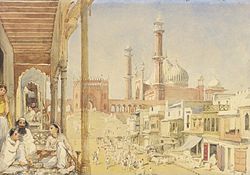Urdu Bazaar
 India
India
The Urdu Bazaar (literally, 'camp market') is a major market in the walled city of Delhi, India that connected the canal in the middle of Chandni Chowk to Jama Masjid. The original market was destroyed in the aftermath of Indian Rebellion of 1857, but its name survives as a location near the Jama Masjid.
The Urdu language obtained its name from this market. Ghalib lamented on the destruction of Delhi in the aftermath of the failure of the 1857 rebellion: "My dear man, when Urdu Bazaar is no more, where is Urdu? By God, Delhi is no more a city, but a camp, a cantonment. No Fort, no city, no bazaars, ..."[1] Delhi's first Chief Executive Councillor and noted freedom fighter, Mir Mushtaq Ahmad, was a resident here prior to and during his term in office and founded the Janata Cooperative Bank in Urdu Bazaar in 1956 for the benefit of local businesses and residents. His premises also hosted periodic meetings of nationally reputed poets and intellectuals.[citation needed]
Today, the main book publishing, printing and selling markets of the Pakistani cities such as Lahore, Karachi, Rawalpindi are also known as Urdu Bazaar.[2][3][4]
See also
- Arabber
- Bazaar
- Bazaari
- Haat bazaar
- Hawker centre (Asia) a centre where street food is sold
- Market (place)
- Peddler
- Retail
- Street vendor
- Street food
References
- ^ Ghalib, 1797-1869 By Mirza Asadullah Khan Ghalib, Ghalib, Asad-Allāh Ḫān Mīrzā Ġālib, Ralph Russell, Khurshidul Islam Published by Allen & Unwin, 1969
- ^ "Urdu Bazaar, Lahore - Google Maps". Google Maps. Retrieved 14 March 2019.
- ^ "Urdu Bazar, Karachi - Google Maps". Google Maps. Retrieved 14 March 2019.
- ^ "Urdu Bazar, Rawalpindi - Google Maps". Google Maps. Retrieved 14 March 2019.
External links
- Chandni Chowk's website
- For travellers
- Small Description
- Urdu Bazaar Books
- v
- t
- e
- Ashok Nagar
- Ashok Vihar
- Ashram Chowk
- Bawana
- Ber Sarai
- Chanakyapuri
- Chandni Chowk
- Chawri Bazar
- Chittaranjan Park
- Civil Lines
- Connaught Place
- Dabri
- Daryaganj
- Dayanand Colony
- Defence Colony
- Delhi Cantonment
- Derawal Nagar
- Dhaula Kuan
- Dilshad Garden
- Dwarka Sub City
- Gandhi Nagar
- Geetanjali Enclave
- Gole Market
- Golf Links
- Govindpuri
- Greater Kailash
- Green Park
- Gulmohar Park
- Hauz Khas
- Inder Puri
- Jangpura
- Janakpuri
- Kailash Colony
- Kalkaji
- Kamla Nagar
- Kapasheda
- Karol Bagh
- Kashmiri Gate
- Kirti Nagar
- Lajpat Nagar
- Laxmibai Nagar
- Laxmi Nagar
- Lutyens' Delhi
- Mahipalpur
- Malviya Nagar
- Mayapuri
- Mayur Vihar
- Meera Bagh
- Mehrauli
- Moti Bagh
- Moti Nagar
- Model Town
- Munirka
- Najafgarh
- Nangloi
- Naraina Vihar
- Nehru Place
- New Friends Colony
- New Moti Bagh
- Netaji Nagar
- New Delhi
- Nizamuddin East
- Nizamuddin West
- Okhla
- Old Delhi
- Paharganj
- Palam
- Palika Bazaar
- Pandav Nagar
- Paschim Vihar
- Patel Nagar
- Patparganj
- Pitam Pura
- Preet Vihar
- Punjabi Bagh
- Raisina Hill
- Rajouri Garden
- Rajendra Nagar
- Rama Krishna Puram
- Rohini
- Sadar Bazaar
- Safdarjung
- Saket
- Sarita Vihar
- Sarojini Nagar
- Shahdara
- Shahpur Jat
- Shalimar Gardens
- Shastri Park
- Shivaji Place
- Shiv Ram Park
- Shreshtha Vihar
- South Extension
- Tilak Nagar
- Vasant Kunj
- Vasant Vihar
- Vasundhara Enclave
- Vikaspuri
- Yamuna Vihar
- Landmarks
- Hindu temples
- Museums
- Power stations
- Topics
- Universities
 | This South Asian history-related article is a stub. You can help Wikipedia by expanding it. |
- v
- t
- e












